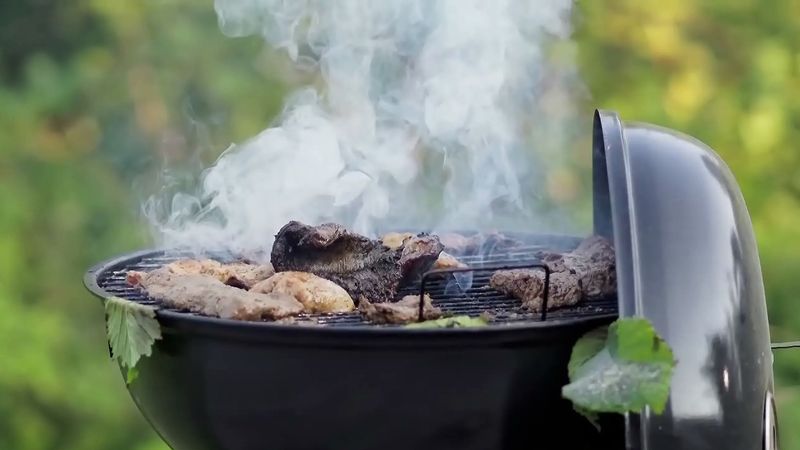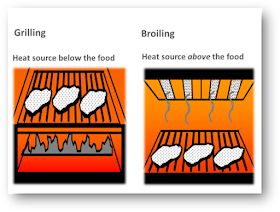Both broiling and grilling are fantastic methods for achieving that coveted seared finish and smoky flavor on your favorite foods.
While they share some similarities, understanding the key differences between broiling vs. grilling will help you decide which technique is best suited for your culinary creation.
In this guide, we’ll explore each method’s specifics, including its heat sources, cooking styles, and unique advantages.
1. Broiling:

Broiling is a cooking method that utilizes direct heat from above, typically emanating from an oven’s broiler element. It’s characterized by its high temperature, making it ideal for achieving a crispy and caramelized exterior on various foods such as meats, fish, and vegetables.
1.1 How Broiling Works and Best Practices:
To broil effectively, preheat your broiler and place the food on a broiler pan or baking sheet lined with foil. Position it beneath the broiler element and monitor it closely to prevent burning. Flipping the food halfway through ensures even browning and cooking.
1.2 Pros and Cons of Broiling:
Broiling offers several advantages, including its convenience as an indoor cooking method and the rapid formation of a deliciously crispy exterior. However, it lacks the distinct smoky flavor associated with grilling and requires vigilance to prevent burning due to the intense heat.
2. Grilling:

Grilling involves cooking food directly over an open flame or hot coals, typically outdoors on a grill. It imparts a delightful smoky flavor to meats and vegetables, making it a favorite cooking method for outdoor gatherings and barbecues.
2.1 Techniques and Optimal Grilling Conditions:
Preheating the grill and cleaning the grates are essential steps for successful grilling. Marinating food beforehand enhances flavor and prevents sticking. Monitoring cooking time, controlling heat, and flipping food at the right intervals ensure even cooking and desired doneness.
2.2 Advantages and Disadvantages of Grilling:
Grilling excels at imparting a smoky flavor, creating a charred exterior, and preserving foods’ natural juiciness. However, it poses risks such as flare-ups, uneven cooking, and the formation of potentially harmful compounds when food is charred or burnt.
3. Flavor and Nutritional Aspects:
Flavor and nutrition are critical considerations in cooking. Broiling yields a slightly charred and crispy exterior, while grilling adds a distinctive smoky flavor. Both methods preserve natural nutrients when cooking times are minimal, but excessive charring can lead to the formation of harmful chemicals.
3.1 Impact on Flavor and Nutritional Value:
Balancing flavor and nutrition entails using proper cooking techniques to avoid excessive charring or burning. By maintaining optimal cooking times and temperatures, you can ensure delicious and nutritious meals that satisfy both palate and health.
Health Considerations:

While both broiling and grilling can be healthy cooking methods, precautions are necessary to minimize risks. Broiling may lead to the formation of harmful chemicals if food is overcooked or charred while grilling also poses concerns regarding the generation of potential carcinogens.
Comparison and Recommendations:
Broiling and grilling have distinct characteristics and are suitable for different types of food. Broiling excels in quick cooking and caramelizaton, while grilling offers a smoky flavor and is ideal for larger cuts of meat. Experimentation with both methods can help determine the best fit for various dishes.
Conclusion:
Broiling and grilling offer distinct culinary experiences, each with its merits and considerations. By understanding their techniques, flavor impacts, and health implications, you can make informed decisions when selecting the appropriate method for your cooking endeavors. Whether you’re craving the charred crispiness of broiling or the savory smokiness of grilling, experimenting with these techniques can elevate your culinary repertoire and delight your taste buds.
References:
- https://www.thespruceeats.com/grilling-versus-broiling-331535
- https://www.masterclass.com/articles/broiling-vs-grilling
FAQ About Cooking Methods: Broiling vs. Grilling
Q: What is broiling and grilling?
A: Broiling and grilling are both dry heat cooking methods that use high temperatures to cook food. Broiling is done in an oven, where the heat source is located on top, while grilling is done on a grill with the heat source beneath the food.
Q: What are the main differences between broiling and grilling?
A: One main difference is the heat source location, with broiling using overhead heat and grilling using heat from below. Broiling cooks food faster due to the direct heat, while grilling imparts a smoky flavor from the grill.
Q: Can the same recipes be used for broiling and grilling?
A: Yes, many recipes can be easily adapted for both broiling and grilling. However, adjustments may be needed in cooking times and temperature settings to achieve the desired results for each method.
Q: Which method is healthier, broiling or grilling?
A: Both broiling and grilling are healthy cooking methods, requiring little to no added fats. However, grilling may pose a higher risk of forming potentially harmful compounds due to the direct exposure of food to flames.
Q: What types of foods are best suited for broiling vs grilling?
A: Broiling is great for cooking thinner cuts of meat, seafood, and vegetables that require quick cooking at high temperatures. Grilling works well for larger cuts of meat, kebabs, and foods that benefit from the smoky flavor imparted by the grill.

The Finer Diner has a rich history deeply rooted in the Mt. Oliver and Hilltop community. Our journey began with a simple yet ambitious vision – to create a welcoming space where friends and families could come together to enjoy delicious, comforting meals in a classic diner-style setting. Since our establishment, we have been dedicated to serving food, creating lasting memories, and fostering a sense of belonging within our community. Our commitment to quality, authenticity, and exceptional service has been the cornerstone of our success.